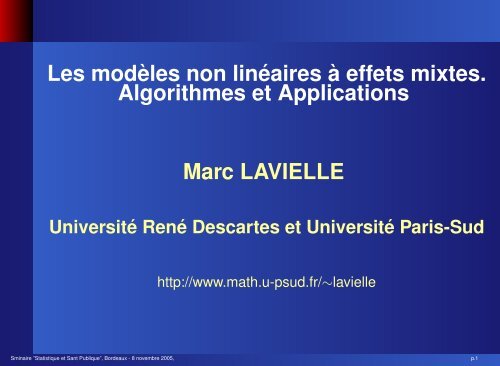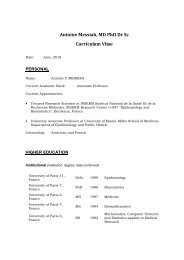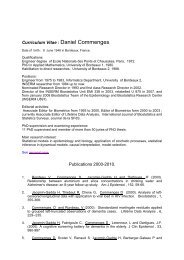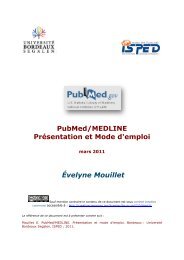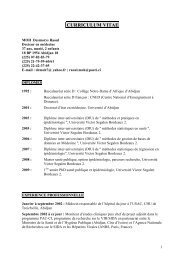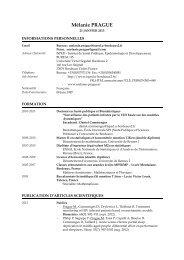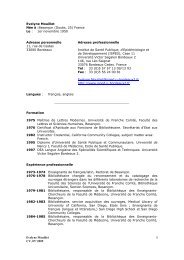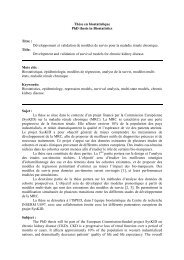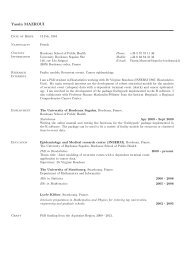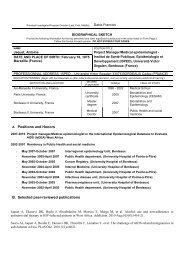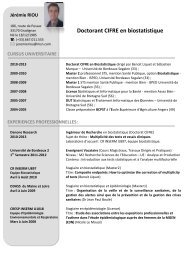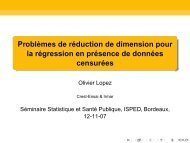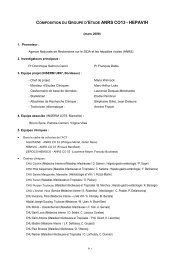Les modèles non linéaires à effets mixtes - Isped
Les modèles non linéaires à effets mixtes - Isped
Les modèles non linéaires à effets mixtes - Isped
Create successful ePaper yourself
Turn your PDF publications into a flip-book with our unique Google optimized e-Paper software.
<strong>Les</strong> modèles <strong>non</strong> linéaires à <strong>effets</strong> <strong>mixtes</strong>.<br />
Algorithmes et Applications<br />
Marc LAVIELLE<br />
Université René Descartes et Université Paris-Sud<br />
http://www.math.u-psud.fr/∼lavielle<br />
Sminaire ”Statistique et Sant Publique”, Bordeaux - 8 novembre 2005, p.1
<strong>Les</strong> modèles <strong>non</strong> linéaires à <strong>effets</strong> <strong>mixtes</strong>.<br />
Algorithmes et Applications<br />
Marc LAVIELLE<br />
Université René Descartes et Université Paris-Sud<br />
http://www.math.u-psud.fr/∼lavielle<br />
(en collaboration avec les membres du groupe MONOLIX)<br />
Sminaire ”Statistique et Sant Publique”, Bordeaux - 8 novembre 2005, p.1
A pharmacokinetics example : theophylline<br />
12 patients:<br />
12<br />
1<br />
10<br />
8<br />
6<br />
4<br />
2<br />
0<br />
0 5 10 15 20 25<br />
Sminaire ”Statistique et Sant Publique”, Bordeaux - 8 novembre 2005, p.2
A pharmacokinetics example : theophylline<br />
12 patients:<br />
12<br />
1<br />
10<br />
8<br />
6<br />
4<br />
2<br />
0<br />
0 5 10 15 20 25<br />
On aimerait construire un modèle qui permette de décrire chaque<br />
courbe individuelle par le même modèle paramétrique, en considérant<br />
que chaque courbe est paramétrée par ses propres paramètres<br />
individuels<br />
Sminaire ”Statistique et Sant Publique”, Bordeaux - 8 novembre 2005, p.2
One compartment model<br />
(oral administration, first-order absortion and elimination)<br />
D absortion (rate k a)<br />
−−−−−−−−−−−→<br />
DRUG AMOUNT Q(t)<br />
elimination (rate k e )<br />
−−−−−−−−−−−→<br />
Sminaire ”Statistique et Sant Publique”, Bordeaux - 8 novembre 2005, p.3
One compartment model<br />
(oral administration, first-order absortion and elimination)<br />
D absortion (rate k a)<br />
−−−−−−−−−−−→<br />
DRUG AMOUNT Q(t)<br />
elimination (rate k e )<br />
−−−−−−−−−−−→<br />
Q a (t): amount at absorption site.<br />
dQ<br />
dt (t) = k aQ a (t) − k e Q(t)<br />
dQ a<br />
dt (t) = −k aQ a (t)<br />
Sminaire ”Statistique et Sant Publique”, Bordeaux - 8 novembre 2005, p.3
One compartment model<br />
(oral administration, first-order absortion and elimination)<br />
D absortion (rate k a)<br />
−−−−−−−−−−−→<br />
DRUG AMOUNT Q(t)<br />
elimination (rate k e )<br />
−−−−−−−−−−−→<br />
Q a (t): amount at absorption site.<br />
C(t) = Q(t)<br />
V<br />
dQ<br />
dt (t) = k aQ a (t) − k e Q(t)<br />
dQ a<br />
dt (t) = −k aQ a (t)<br />
= D k ak e<br />
Cl(k a − k e )<br />
(e −k et − e −k at )<br />
Cl, k a et k e sont des paramètres physiologiques individuels.<br />
Sminaire ”Statistique et Sant Publique”, Bordeaux - 8 novembre 2005, p.3
oral administration, first-order absortion and elimination<br />
Sminaire ”Statistique et Sant Publique”, Bordeaux - 8 novembre 2005, p.4
Viral load decrease during anti-HIV treatment<br />
15 patients:<br />
6<br />
6<br />
6<br />
6<br />
6<br />
5<br />
5<br />
5<br />
5<br />
5<br />
4<br />
4<br />
4<br />
4<br />
4<br />
3<br />
3<br />
3<br />
3<br />
3<br />
2<br />
2<br />
2<br />
2<br />
2<br />
1<br />
1<br />
1<br />
1<br />
1<br />
0 50 100<br />
0 50 100<br />
0 50 100<br />
0 50 100<br />
0 50 100<br />
6<br />
6<br />
6<br />
6<br />
6<br />
5<br />
5<br />
5<br />
5<br />
5<br />
4<br />
4<br />
4<br />
4<br />
4<br />
3<br />
3<br />
3<br />
3<br />
3<br />
2<br />
2<br />
2<br />
2<br />
2<br />
1<br />
1<br />
1<br />
1<br />
1<br />
0 50 100<br />
0 50 100<br />
0 50 100<br />
0 50 100<br />
0 50 100<br />
6<br />
6<br />
6<br />
6<br />
6<br />
5<br />
5<br />
5<br />
5<br />
5<br />
4<br />
4<br />
4<br />
4<br />
4<br />
3<br />
3<br />
3<br />
3<br />
3<br />
2<br />
2<br />
2<br />
2<br />
2<br />
1<br />
1<br />
1<br />
1<br />
1<br />
0 50 100<br />
0 50 100<br />
0 50 100<br />
0 50 100<br />
0 50 100<br />
Sminaire ”Statistique et Sant Publique”, Bordeaux - 8 novembre 2005, p.5
Viral load decrease during anti-HIV treatment<br />
4<br />
3.5<br />
3<br />
log(CV) (cp/ml)<br />
2.5<br />
2<br />
1.5<br />
1<br />
0.5<br />
0 20 40 60 80 100 120<br />
time (weeks)<br />
Sminaire ”Statistique et Sant Publique”, Bordeaux - 8 novembre 2005, p.6
Viral load decrease during anti-HIV treatment<br />
4<br />
3.5<br />
3<br />
log(CV) (cp/ml)<br />
2.5<br />
2<br />
1.5<br />
1<br />
0.5<br />
0 20 40 60 80 100 120<br />
time (weeks)<br />
L(t) = A 1 e −λ 1t + A 2 e −λ 2t<br />
; (λ 1 > λ 2 )<br />
Initial rate constant of viral load decrease : λ 1<br />
Terminal rate constant of viral load decrease : λ 2<br />
A 1 , A 2 , λ 1 et λ 2 sont des paramètres physiologiques individuels.<br />
Sminaire ”Statistique et Sant Publique”, Bordeaux - 8 novembre 2005, p.6
Crop yield responses to applied fertilizer on 37 site-year<br />
12<br />
1<br />
11<br />
10<br />
9<br />
8<br />
7<br />
6<br />
5<br />
4<br />
3<br />
0 50 100 150 200 250 300 350<br />
Sminaire ”Statistique et Sant Publique”, Bordeaux - 8 novembre 2005, p.7
Evolution of the weight of 560 cows<br />
1200<br />
1<br />
1000<br />
800<br />
600<br />
400<br />
200<br />
0<br />
0 200 400 600 800 1000 1200 1400 1600 1800 2000<br />
Sminaire ”Statistique et Sant Publique”, Bordeaux - 8 novembre 2005, p.8
Le modèle mixte<br />
On aimerait construire un modèle qui permette de décrire chaque<br />
courbe individuelle par le même modèle paramétrique,<br />
Sminaire ”Statistique et Sant Publique”, Bordeaux - 8 novembre 2005, p.9
Le modèle mixte<br />
On aimerait construire un modèle qui permette de décrire chaque<br />
courbe individuelle par le même modèle paramétrique,<br />
en considérant que chaque courbe est paramétrée par ses propres<br />
paramètres individuels,<br />
Sminaire ”Statistique et Sant Publique”, Bordeaux - 8 novembre 2005, p.9
Le modèle mixte<br />
On aimerait construire un modèle qui permette de décrire chaque<br />
courbe individuelle par le même modèle paramétrique,<br />
en considérant que chaque courbe est paramétrée par ses propres<br />
paramètres individuels,<br />
en considérant que ces paramètres individuels fluctuent autour d’un<br />
paramètre moyen de population.<br />
Sminaire ”Statistique et Sant Publique”, Bordeaux - 8 novembre 2005, p.9
<strong>Les</strong> modèles à <strong>effets</strong> <strong>mixtes</strong><br />
Sminaire ”Statistique et Sant Publique”, Bordeaux - 8 novembre 2005, p.10
The (<strong>non</strong>linear) mixed effects model<br />
Sminaire ”Statistique et Sant Publique”, Bordeaux - 8 novembre 2005, p.11
The (<strong>non</strong>linear) mixed effects model<br />
y ij = a(t ij , φ i ) + b(t ij , φ i )ε ij<br />
; 1 ≤ i ≤ n ; 1 ≤ j ≤ n i<br />
(y ij ) are the observations<br />
a et b are known regression functions.<br />
(t ij ) are the measurement times.<br />
(ε ij ) are intra-individual fluctuations.<br />
(φ i ) are the individual (random) parameters.<br />
Sminaire ”Statistique et Sant Publique”, Bordeaux - 8 novembre 2005, p.11
The (<strong>non</strong>linear) mixed effects model<br />
y ij = a(t ij , φ i ) + b(t ij , φ i )ε ij<br />
; 1 ≤ i ≤ n ; 1 ≤ j ≤ n i<br />
(y ij ) are the observations<br />
a et b are known regression functions.<br />
(t ij ) are the measurement times.<br />
(ε ij ) are intra-individual fluctuations.<br />
(φ i ) are the individual (random) parameters.<br />
φ i ∼ i.i.d. π<br />
Sminaire ”Statistique et Sant Publique”, Bordeaux - 8 novembre 2005, p.11
The (<strong>non</strong>linear) mixed effects model<br />
(model without covariate)<br />
y ij = a(t ij , φ i ) + b(t ij , φ i )ε ij<br />
; 1 ≤ i ≤ n ; 1 ≤ j ≤ n i<br />
φ i ∼ i.i.d. N (µ, Γ)<br />
Sminaire ”Statistique et Sant Publique”, Bordeaux - 8 novembre 2005, p.12
The (<strong>non</strong>linear) mixed effects model<br />
(model without covariate)<br />
y ij = a(t ij , φ i ) + b(t ij , φ i )ε ij<br />
; 1 ≤ i ≤ n ; 1 ≤ j ≤ n i<br />
Fixed effects : µ<br />
Random effects : (φ i − µ).<br />
φ i ∼ i.i.d. N (µ, Γ)<br />
Sminaire ”Statistique et Sant Publique”, Bordeaux - 8 novembre 2005, p.12
The (<strong>non</strong>linear) mixed effects model<br />
(model with covariate)<br />
y ij = a(t ij , φ i ) + b(t ij , φ i )ε ij<br />
; 1 ≤ i ≤ n ; 1 ≤ j ≤ n i<br />
φ i = A i µ + B i η i<br />
A i , B i : design matrix formed with covariates<br />
η i ∼ i.i.d. N (0, Γ)<br />
Fixed effects : µ<br />
Random effects : (η i )<br />
Sminaire ”Statistique et Sant Publique”, Bordeaux - 8 novembre 2005, p.13
The (<strong>non</strong>linear) mixed effects model<br />
(model with covariate)<br />
y ij = a(t ij , φ i ) + b(t ij , φ i )ε ij<br />
; 1 ≤ i ≤ n ; 1 ≤ j ≤ n i<br />
φ i = A i µ + B i η i<br />
A i , B i : design matrix formed with covariates<br />
η i ∼ i.i.d. N (0, Γ)<br />
Fixed effects : µ<br />
Random effects : (η i )<br />
ε ij ∼ i.i.d. N (0, σ 2 )<br />
Sminaire ”Statistique et Sant Publique”, Bordeaux - 8 novembre 2005, p.13
The (<strong>non</strong>linear) mixed effects model<br />
(model with covariate)<br />
y ij = a(t ij , φ i ) + b(t ij , φ i )ε ij<br />
; 1 ≤ i ≤ n ; 1 ≤ j ≤ n i<br />
φ i = A i µ + B i η i<br />
A i , B i : design matrix formed with covariates<br />
η i ∼ i.i.d. N (0, Γ)<br />
Fixed effects : µ<br />
Random effects : (η i )<br />
ε ij ∼ i.i.d. N (0, σ 2 )<br />
(Hyper)parameters of the model: θ = (µ, Γ, σ 2 ).<br />
Sminaire ”Statistique et Sant Publique”, Bordeaux - 8 novembre 2005, p.13
Objectifs<br />
Estimation<br />
Estimer l’ensemble des paramètres du modèle θ<br />
Calculer un intervalle de confiance<br />
Sminaire ”Statistique et Sant Publique”, Bordeaux - 8 novembre 2005, p.14
Objectifs<br />
Estimation<br />
Estimer l’ensemble des paramètres du modèle θ<br />
Calculer un intervalle de confiance<br />
Sélection de modèle<br />
Sélectionner le modèle de covariables<br />
Sélectionner le modèle de covariance des <strong>effets</strong> aléatoires<br />
Sminaire ”Statistique et Sant Publique”, Bordeaux - 8 novembre 2005, p.14
Objectifs<br />
Estimation<br />
Estimer l’ensemble des paramètres du modèle θ<br />
Calculer un intervalle de confiance<br />
Sélection de modèle<br />
Sélectionner le modèle de covariables<br />
Sélectionner le modèle de covariance des <strong>effets</strong> aléatoires<br />
Tests d’hypothèses<br />
Comparer deux traitements<br />
Tester si un effet est fixe ou aléatoire<br />
Sminaire ”Statistique et Sant Publique”, Bordeaux - 8 novembre 2005, p.14
Objectifs<br />
Estimation<br />
Estimer l’ensemble des paramètres du modèle θ<br />
Calculer un intervalle de confiance<br />
Sélection de modèle<br />
Sélectionner le modèle de covariables<br />
Sélectionner le modèle de covariance des <strong>effets</strong> aléatoires<br />
Tests d’hypothèses<br />
Comparer deux traitements<br />
Tester si un effet est fixe ou aléatoire<br />
Optimisation de plans d’expérience<br />
Determiner le design qui permet la meileure estimation du modèle<br />
Sminaire ”Statistique et Sant Publique”, Bordeaux - 8 novembre 2005, p.14
<strong>Les</strong> modèles <strong>mixtes</strong> en plein boom ...<br />
<strong>Les</strong> modèles (<strong>non</strong> linéaires) à <strong>effets</strong> <strong>mixtes</strong>, sont utilisés aujourd’hui<br />
dans de très nombreux domaines d’application:<br />
pharmacologie, oncologie, neurosciences, agronomie, génétique<br />
animale, climatologie, écologie . . .<br />
Sminaire ”Statistique et Sant Publique”, Bordeaux - 8 novembre 2005, p.15
<strong>Les</strong> modèles <strong>mixtes</strong> en plein boom ...<br />
<strong>Les</strong> modèles (<strong>non</strong> linéaires) à <strong>effets</strong> <strong>mixtes</strong>, sont utilisés aujourd’hui<br />
dans de très nombreux domaines d’application:<br />
pharmacologie, oncologie, neurosciences, agronomie, génétique<br />
animale, climatologie, écologie . . .<br />
Nombre d’articles référencés dans Medline avec le mot clé<br />
“mixed effects model” :<br />
40 entre 1980 et 1989<br />
303 entre 1990 et 1999<br />
523 depuis 2000<br />
Sminaire ”Statistique et Sant Publique”, Bordeaux - 8 novembre 2005, p.15
<strong>Les</strong> modèles <strong>mixtes</strong> en plein boom ...<br />
<strong>Les</strong> modèles (<strong>non</strong> linéaires) à <strong>effets</strong> <strong>mixtes</strong>, sont utilisés aujourd’hui<br />
dans de très nombreux domaines d’application:<br />
pharmacologie, oncologie, neurosciences, agronomie, génétique<br />
animale, climatologie, écologie . . .<br />
Nombre d’articles référencés dans Medline avec le mot clé<br />
“mixed effects model” :<br />
40 entre 1980 et 1989<br />
303 entre 1990 et 1999<br />
523 depuis 2000<br />
Développement récents en statistique :<br />
Modèles à données incomplètes<br />
Sélection de modèles<br />
Optimisation de protocoles<br />
Sminaire ”Statistique et Sant Publique”, Bordeaux - 8 novembre 2005, p.15
Le groupe de travail MONOLIX<br />
Groupe de travail pluridisciplinaire animé par France Mentré (Inserm et<br />
Université Paris 7) et Marc Lavielle depuis octobre 2003 et regoupant<br />
une vingtaine de participants (Inserm, INRA, INA-PG, CEMAGREF,<br />
Ecole Vétérinaire, Universités P5, P11, P13, Lyon 1)<br />
Sminaire ”Statistique et Sant Publique”, Bordeaux - 8 novembre 2005, p.16
Le groupe de travail MONOLIX<br />
Groupe de travail pluridisciplinaire animé par France Mentré (Inserm et<br />
Université Paris 7) et Marc Lavielle depuis octobre 2003 et regoupant<br />
une vingtaine de participants (Inserm, INRA, INA-PG, CEMAGREF,<br />
Ecole Vétérinaire, Universités P5, P11, P13, Lyon 1)<br />
des collaborations en statistique:<br />
Modèles avec ODE, SDE<br />
Modèles avec données manquantes ou censurées<br />
Estimation REML<br />
Algorithme PX-SAEM<br />
Sélection de modèles<br />
Tests de validité<br />
Sminaire ”Statistique et Sant Publique”, Bordeaux - 8 novembre 2005, p.16
Le groupe de travail MONOLIX<br />
Groupe de travail pluridisciplinaire animé par France Mentré (Inserm et<br />
Université Paris 7) et Marc Lavielle depuis octobre 2003 et regoupant<br />
une vingtaine de participants (Inserm, INRA, INA-PG, CEMAGREF,<br />
Ecole Vétérinaire, Universités P5, P11, P13, Lyon 1)<br />
des collaborations en statistique:<br />
Modèles avec ODE, SDE<br />
Modèles avec données manquantes ou censurées<br />
Estimation REML<br />
Algorithme PX-SAEM<br />
Sélection de modèles<br />
Tests de validité<br />
des applications en pharmacologie, en oncologie, en agronomie, en<br />
génétique animale,. . .<br />
Sminaire ”Statistique et Sant Publique”, Bordeaux - 8 novembre 2005, p.16
Le groupe de travail MONOLIX<br />
des thèses en co-direction :<br />
Cristian Meza : M. Lavielle (P11) et J.L. Foulley (INRA)<br />
Adeline Samson : M. Lavielle (P11) et F. Mentré (INSERM)<br />
Sminaire ”Statistique et Sant Publique”, Bordeaux - 8 novembre 2005, p.17
Le groupe de travail MONOLIX<br />
des thèses en co-direction :<br />
Cristian Meza : M. Lavielle (P11) et J.L. Foulley (INRA)<br />
Adeline Samson : M. Lavielle (P11) et F. Mentré (INSERM)<br />
des publications communes :<br />
soumis ou à paraître dans : Biostatistics, Statistics in Medecine, Genetics,<br />
Journal of Agricultural Biological and Environmental Statistics, Journal of Statistics<br />
and Planning Inference, Statistics and Computation, Computational Statistics and<br />
Data Analysis, Journal of PK/PD...<br />
Sminaire ”Statistique et Sant Publique”, Bordeaux - 8 novembre 2005, p.17
Le groupe de travail MONOLIX<br />
des thèses en co-direction :<br />
Cristian Meza : M. Lavielle (P11) et J.L. Foulley (INRA)<br />
Adeline Samson : M. Lavielle (P11) et F. Mentré (INSERM)<br />
des publications communes :<br />
soumis ou à paraître dans : Biostatistics, Statistics in Medecine, Genetics,<br />
Journal of Agricultural Biological and Environmental Statistics, Journal of Statistics<br />
and Planning Inference, Statistics and Computation, Computational Statistics and<br />
Data Analysis, Journal of PK/PD...<br />
des congrès:<br />
SMAI 2005 (organisation d’un mini-symposium),<br />
SFdS 2005 (organisation d’une session spéciale),<br />
PAGE (Population Approach Group in Europe) 2004 et 2005,<br />
Sminaire ”Statistique et Sant Publique”, Bordeaux - 8 novembre 2005, p.17
Le groupe de travail MONOLIX<br />
des thèses en co-direction :<br />
Cristian Meza : M. Lavielle (P11) et J.L. Foulley (INRA)<br />
Adeline Samson : M. Lavielle (P11) et F. Mentré (INSERM)<br />
des publications communes :<br />
soumis ou à paraître dans : Biostatistics, Statistics in Medecine, Genetics,<br />
Journal of Agricultural Biological and Environmental Statistics, Journal of Statistics<br />
and Planning Inference, Statistics and Computation, Computational Statistics and<br />
Data Analysis, Journal of PK/PD...<br />
des congrès:<br />
SMAI 2005 (organisation d’un mini-symposium),<br />
SFdS 2005 (organisation d’une session spéciale),<br />
PAGE (Population Approach Group in Europe) 2004 et 2005,<br />
le logiciel Monolix<br />
Sminaire ”Statistique et Sant Publique”, Bordeaux - 8 novembre 2005, p.17
Le groupe de travail MONOLIX<br />
des thèses en co-direction :<br />
Cristian Meza : M. Lavielle (P11) et J.L. Foulley (INRA)<br />
Adeline Samson : M. Lavielle (P11) et F. Mentré (INSERM)<br />
des publications communes :<br />
soumis ou à paraître dans : Biostatistics, Statistics in Medecine, Genetics,<br />
Journal of Agricultural Biological and Environmental Statistics, Journal of Statistics<br />
and Planning Inference, Statistics and Computation, Computational Statistics and<br />
Data Analysis, Journal of PK/PD...<br />
des congrès:<br />
SMAI 2005 (organisation d’un mini-symposium),<br />
SFdS 2005 (organisation d’une session spéciale),<br />
PAGE (Population Approach Group in Europe) 2004 et 2005,<br />
le logiciel Monolix<br />
un projet ANR (programme <strong>non</strong> thématique, CSD 5)<br />
Sminaire ”Statistique et Sant Publique”, Bordeaux - 8 novembre 2005, p.17
<strong>Les</strong> méthodes d’estimation<br />
existantes<br />
Sminaire ”Statistique et Sant Publique”, Bordeaux - 8 novembre 2005, p.18
Some existing methods<br />
Sminaire ”Statistique et Sant Publique”, Bordeaux - 8 novembre 2005, p.19
Some existing methods<br />
1. Methods based on individual estimates<br />
i) Estimate the individual parameters (φ i ),<br />
ii) Estimate θ using (̂φ i ).<br />
Sminaire ”Statistique et Sant Publique”, Bordeaux - 8 novembre 2005, p.19
Some existing methods<br />
1. Methods based on individual estimates<br />
i) Estimate the individual parameters (φ i ),<br />
ii) Estimate θ using (̂φ i ).<br />
=⇒ Requires a large number of observations per subject.<br />
Sminaire ”Statistique et Sant Publique”, Bordeaux - 8 novembre 2005, p.19
Some existing methods<br />
2. Methods based on approximations of the likelihood<br />
Sminaire ”Statistique et Sant Publique”, Bordeaux - 8 novembre 2005, p.20
Some existing methods<br />
2. Methods based on approximations of the likelihood<br />
First order methods (FO, Beal and Sheiner, 1982)<br />
φ i = µ + η i<br />
y ij ≈ a(t ij , µ) + da<br />
dt a(t ij, µ)η i + b(t ij , µ)ε ij<br />
i) NONMEM package (very popular in pharmacokinetics)<br />
ii) SAS proc NLMIXED (using the method=firo option)<br />
Sminaire ”Statistique et Sant Publique”, Bordeaux - 8 novembre 2005, p.20
Some existing methods<br />
2. Methods based on approximations of the likelihood<br />
First order methods (FO, Beal and Sheiner, 1982)<br />
φ i = µ + η i<br />
y ij ≈ a(t ij , µ) + da<br />
dt a(t ij, µ)η i + b(t ij , µ)ε ij<br />
i) NONMEM package (very popular in pharmacokinetics)<br />
ii) SAS proc NLMIXED (using the method=firo option)<br />
First order conditional methods (FOCE, Lindstrom and Bates, 1990)<br />
y ij ≈ a(t ij , ˆφ i ) + da<br />
dt a(t ij, ˆφ i )(φ i − ˆφ i ) + b(t ij , ˆφ i )ε ij<br />
ˆφ i maximizes the conditional distribution p(φ i |y i ; θ)<br />
i) NONMEM package (FOCE option)<br />
ii) SAS proc NLMIXED (using the method=eblup option)<br />
iii) Splus/R function NLME<br />
Sminaire ”Statistique et Sant Publique”, Bordeaux - 8 novembre 2005, p.20
Some existing methods<br />
3. Methods based on the exact likelihood<br />
EM algorithm (Dempster et al, 1977)<br />
MCEM algorithm (Walker, 1996)<br />
SPML algorithm (Concordet and Nunez, 2002)<br />
SAEM algorithm (Delyon, Lavielle and Moulines, 1999 ; Kuhn and Lavielle, 2003)<br />
MC-PEM algorithm (Bauer and Guzy, 2004)<br />
Sminaire ”Statistique et Sant Publique”, Bordeaux - 8 novembre 2005, p.21
The incomplete data model<br />
The complete likelihood f of (y, φ) belongs to a parametric family<br />
{f(y, φ; θ), θ ∈ Θ}.<br />
Sminaire ”Statistique et Sant Publique”, Bordeaux - 8 novembre 2005, p.22
The incomplete data model<br />
The complete likelihood f of (y, φ) belongs to a parametric family<br />
{f(y, φ; θ), θ ∈ Θ}.<br />
Objectives<br />
Compute the value θ ML that maximises the likelihood g(y; θ) of the<br />
observed data<br />
Sminaire ”Statistique et Sant Publique”, Bordeaux - 8 novembre 2005, p.22
The incomplete data model<br />
The complete likelihood f of (y, φ) belongs to a parametric family<br />
{f(y, φ; θ), θ ∈ Θ}.<br />
Objectives<br />
Compute the value θ ML that maximises the likelihood g(y; θ) of the<br />
observed data<br />
Estimate the likelihood of the observations g(y; θ ML ).<br />
Sminaire ”Statistique et Sant Publique”, Bordeaux - 8 novembre 2005, p.22
The incomplete data model<br />
The complete likelihood f of (y, φ) belongs to a parametric family<br />
{f(y, φ; θ), θ ∈ Θ}.<br />
Objectives<br />
Compute the value θ ML that maximises the likelihood g(y; θ) of the<br />
observed data<br />
Estimate the likelihood of the observations g(y; θ ML ).<br />
Estimate the Fisher information matrix −∂ 2 θ log g(y; θML ).<br />
Sminaire ”Statistique et Sant Publique”, Bordeaux - 8 novembre 2005, p.22
The EM algorithm (Expectation-Maximization)<br />
(Dempster, Laird et Rubin, 1977)<br />
Complete-data model: (y, φ) ∼ f(·, · ; θ) ; only y is observed.<br />
Sminaire ”Statistique et Sant Publique”, Bordeaux - 8 novembre 2005, p.23
The EM algorithm (Expectation-Maximization)<br />
(Dempster, Laird et Rubin, 1977)<br />
Complete-data model: (y, φ) ∼ f(·, · ; θ) ; only y is observed.<br />
Iteration k of the algorithm:<br />
step E : evaluate the quantity<br />
Q k (θ) = E[log f(y, φ; θ)|y; θ k−1 ]<br />
Sminaire ”Statistique et Sant Publique”, Bordeaux - 8 novembre 2005, p.23
The EM algorithm (Expectation-Maximization)<br />
(Dempster, Laird et Rubin, 1977)<br />
Complete-data model: (y, φ) ∼ f(·, · ; θ) ; only y is observed.<br />
Iteration k of the algorithm:<br />
step E : evaluate the quantity<br />
Q k (θ) = E[log f(y, φ; θ)|y; θ k−1 ]<br />
step M : update the estimation of θ:<br />
θ k = Argmax Q k (θ)<br />
Sminaire ”Statistique et Sant Publique”, Bordeaux - 8 novembre 2005, p.23
Convergence of EM<br />
Dempster et al. (1977), Wu (1983)<br />
Convergence of (θ k ) to a stationary point ̂θ g of the observed likelihood is<br />
ensured under some regularity conditions.<br />
Sminaire ”Statistique et Sant Publique”, Bordeaux - 8 novembre 2005, p.24
Convergence of EM<br />
Dempster et al. (1977), Wu (1983)<br />
Convergence of (θ k ) to a stationary point ̂θ g of the observed likelihood is<br />
ensured under some regularity conditions.<br />
Some practical drawbacks of EM:<br />
Nature of the limiting point.<br />
Convergence depends on the initial guess.<br />
Slow convergence of EM.<br />
Sminaire ”Statistique et Sant Publique”, Bordeaux - 8 novembre 2005, p.24
Convergence of EM<br />
Dempster et al. (1977), Wu (1983)<br />
Convergence of (θ k ) to a stationary point ̂θ g of the observed likelihood is<br />
ensured under some regularity conditions.<br />
Some practical drawbacks of EM:<br />
Nature of the limiting point.<br />
Convergence depends on the initial guess.<br />
Slow convergence of EM.<br />
Evaluation of Q k (θ) = E[log f(y, φ; θ)|y; θ k−1 ] during step E.<br />
Sminaire ”Statistique et Sant Publique”, Bordeaux - 8 novembre 2005, p.24
Convergence of EM<br />
Dempster et al. (1977), Wu (1983)<br />
Convergence of (θ k ) to a stationary point ̂θ g of the observed likelihood is<br />
ensured under some regularity conditions.<br />
Some practical drawbacks of EM:<br />
Nature of the limiting point.<br />
Convergence depends on the initial guess.<br />
Slow convergence of EM.<br />
Evaluation of Q k (θ) = E[log f(y, φ; θ)|y; θ k−1 ] during step E.<br />
=⇒ use a simulated sequence φ<br />
Sminaire ”Statistique et Sant Publique”, Bordeaux - 8 novembre 2005, p.24
A Stochastic Approximation<br />
version of EM<br />
Sminaire ”Statistique et Sant Publique”, Bordeaux - 8 novembre 2005, p.25
The SAEM algorithm (Stochastic Approximation of EM)<br />
Delyon, Lavielle and Moulines (1999)<br />
Sminaire ”Statistique et Sant Publique”, Bordeaux - 8 novembre 2005, p.26
The SAEM algorithm (Stochastic Approximation of EM)<br />
Delyon, Lavielle and Moulines (1999)<br />
Iteration k of the algorithm:<br />
draw the <strong>non</strong> observed data φ k with the conditional distribution<br />
p Φ|Y ( · |y; θ k−1 ).<br />
Sminaire ”Statistique et Sant Publique”, Bordeaux - 8 novembre 2005, p.26
The SAEM algorithm (Stochastic Approximation of EM)<br />
Delyon, Lavielle and Moulines (1999)<br />
Iteration k of the algorithm:<br />
draw the <strong>non</strong> observed data φ k with the conditional distribution<br />
p Φ|Y ( · |y; θ k−1 ).<br />
Stochastic approximation<br />
Q k (θ) = Q k−1 (θ) + γ k [log f(y, φ k ; θ) − Q k−1 (θ)]<br />
where (γ k ) is a decreasing sequence such that ∑ γ k = +∞ and<br />
∑ γ<br />
2<br />
k<br />
< +∞ .<br />
Sminaire ”Statistique et Sant Publique”, Bordeaux - 8 novembre 2005, p.26
The SAEM algorithm (Stochastic Approximation of EM)<br />
Delyon, Lavielle and Moulines (1999)<br />
Iteration k of the algorithm:<br />
draw the <strong>non</strong> observed data φ k with the conditional distribution<br />
p Φ|Y ( · |y; θ k−1 ).<br />
Stochastic approximation<br />
Q k (θ) = Q k−1 (θ) + γ k [log f(y, φ k ; θ) − Q k−1 (θ)]<br />
where (γ k ) is a decreasing sequence such that ∑ γ k = +∞ and<br />
∑ γ<br />
2<br />
k<br />
< +∞ .<br />
Maximization :<br />
θ k = Argmax Q k (θ)<br />
Sminaire ”Statistique et Sant Publique”, Bordeaux - 8 novembre 2005, p.26
Convergence of SAEM<br />
Delyon, Lavielle et Moulines (1999)<br />
For exponential models, the sequence (θ k ) converges almost surely<br />
toward a stationary point ̂θ g of the observed likelihood g under very<br />
general conditions.<br />
Sminaire ”Statistique et Sant Publique”, Bordeaux - 8 novembre 2005, p.27
Convergence of SAEM<br />
Delyon, Lavielle et Moulines (1999)<br />
For exponential models, the sequence (θ k ) converges almost surely<br />
toward a stationary point ̂θ g of the observed likelihood g under very<br />
general conditions.<br />
Some weak hypothesis ensure the convergence to a (local) maximum of<br />
the likelihood<br />
Sminaire ”Statistique et Sant Publique”, Bordeaux - 8 novembre 2005, p.27
Convergence of SAEM<br />
Delyon, Lavielle et Moulines (1999)<br />
For exponential models, the sequence (θ k ) converges almost surely<br />
toward a stationary point ̂θ g of the observed likelihood g under very<br />
general conditions.<br />
Some weak hypothesis ensure the convergence to a (local) maximum of<br />
the likelihood<br />
Practical drawbacks:<br />
Convergence depends on the initial guess.<br />
Sminaire ”Statistique et Sant Publique”, Bordeaux - 8 novembre 2005, p.27
Convergence of SAEM<br />
Delyon, Lavielle et Moulines (1999)<br />
For exponential models, the sequence (θ k ) converges almost surely<br />
toward a stationary point ̂θ g of the observed likelihood g under very<br />
general conditions.<br />
Some weak hypothesis ensure the convergence to a (local) maximum of<br />
the likelihood<br />
Practical drawbacks:<br />
Convergence depends on the initial guess.<br />
=⇒ use a simulated annealing version of SAEM<br />
Sminaire ”Statistique et Sant Publique”, Bordeaux - 8 novembre 2005, p.27
Convergence of SAEM<br />
Delyon, Lavielle et Moulines (1999)<br />
For exponential models, the sequence (θ k ) converges almost surely<br />
toward a stationary point ̂θ g of the observed likelihood g under very<br />
general conditions.<br />
Some weak hypothesis ensure the convergence to a (local) maximum of<br />
the likelihood<br />
Practical drawbacks:<br />
Convergence depends on the initial guess.<br />
=⇒ use a simulated annealing version of SAEM<br />
Exact simulation of φ with the conditional distribution not always<br />
possible.<br />
Sminaire ”Statistique et Sant Publique”, Bordeaux - 8 novembre 2005, p.27
Convergence of SAEM<br />
Delyon, Lavielle et Moulines (1999)<br />
For exponential models, the sequence (θ k ) converges almost surely<br />
toward a stationary point ̂θ g of the observed likelihood g under very<br />
general conditions.<br />
Some weak hypothesis ensure the convergence to a (local) maximum of<br />
the likelihood<br />
Practical drawbacks:<br />
Convergence depends on the initial guess.<br />
=⇒ use a simulated annealing version of SAEM<br />
Exact simulation of φ with the conditional distribution not always<br />
possible.<br />
=⇒ use a MCMC method.<br />
Sminaire ”Statistique et Sant Publique”, Bordeaux - 8 novembre 2005, p.27
A Simulated Annealing version of SAEM<br />
Conditional distribution of φ:<br />
p Φ|Y ( φ |y; θ) = C(y; θ)e −U(φ,y;θ)<br />
Sminaire ”Statistique et Sant Publique”, Bordeaux - 8 novembre 2005, p.28
A Simulated Annealing version of SAEM<br />
Conditional distribution of φ:<br />
Temperature parameter T :<br />
p Φ|Y ( φ |y; θ) = C(y; θ)e −U(φ,y;θ)<br />
p (T )<br />
Φ|Y ( φ |y; θ) = C T (y; θ)e − U(φ,y;θ)<br />
T<br />
Sminaire ”Statistique et Sant Publique”, Bordeaux - 8 novembre 2005, p.28
A Simulated Annealing version of SAEM<br />
Conditional distribution of φ:<br />
Temperature parameter T :<br />
p Φ|Y ( φ |y; θ) = C(y; θ)e −U(φ,y;θ)<br />
p (T )<br />
Φ|Y ( φ |y; θ) = C T (y; θ)e − U(φ,y;θ)<br />
T<br />
Choose a decreasing Temperature sequence (T k ) that converges to 1.<br />
Then, at iteration k of SAEM,<br />
Simulation: draw the <strong>non</strong> observed data φ k with the conditional<br />
distribution p (T k)<br />
Φ|Y ( · |y; θ k−1)<br />
Sminaire ”Statistique et Sant Publique”, Bordeaux - 8 novembre 2005, p.28
A Simulated Annealing version of SAEM<br />
Conditional distribution of φ:<br />
Temperature parameter T :<br />
p Φ|Y ( φ |y; θ) = C(y; θ)e −U(φ,y;θ)<br />
p (T )<br />
Φ|Y ( φ |y; θ) = C T (y; θ)e − U(φ,y;θ)<br />
T<br />
Choose a decreasing Temperature sequence (T k ) that converges to 1.<br />
Then, at iteration k of SAEM,<br />
Simulation: draw the <strong>non</strong> observed data φ k with the conditional<br />
distribution p (T k)<br />
Φ|Y ( · |y; θ k−1)<br />
Stochastic approximation<br />
Maximization<br />
Sminaire ”Statistique et Sant Publique”, Bordeaux - 8 novembre 2005, p.28
Coupling SAEM and MCMC<br />
(Kuhn and Lavielle)<br />
Let Π θ be the transition probability of an ergodic Markov Chain with<br />
limiting distribution p Φ|Y (·|y; θ).<br />
Sminaire ”Statistique et Sant Publique”, Bordeaux - 8 novembre 2005, p.29
Coupling SAEM and MCMC<br />
(Kuhn and Lavielle)<br />
Let Π θ be the transition probability of an ergodic Markov Chain with<br />
limiting distribution p Φ|Y (·|y; θ).<br />
Iteration k of the algorithm:<br />
step S : draw φ k according to the transition probability<br />
Π θk−1 (φ k−1 , ·).<br />
Sminaire ”Statistique et Sant Publique”, Bordeaux - 8 novembre 2005, p.29
Coupling SAEM and MCMC<br />
(Kuhn and Lavielle)<br />
Let Π θ be the transition probability of an ergodic Markov Chain with<br />
limiting distribution p Φ|Y (·|y; θ).<br />
Iteration k of the algorithm:<br />
step S : draw φ k according to the transition probability<br />
Π θk−1 (φ k−1 , ·).<br />
Stochastic approximation<br />
Q k (θ) = Q k−1 (θ) + γ k [log f(y, φ k ; θ) − Q k−1 (θ)]<br />
Maximization :<br />
θ k = Argmax Q k (θ)<br />
Sminaire ”Statistique et Sant Publique”, Bordeaux - 8 novembre 2005, p.29
Convergence of the algorithm<br />
(Kuhn and Lavielle)<br />
C1 The chain (φ k ) k≥0 takes its values in a compact subset E of R l .<br />
C2 For any compact subset V of Θ, there exists a real constant L such<br />
that for any (θ, θ ′ ) in V 2<br />
sup |Π θ (x, y) − Π θ ′(x, y)| ≤ L|θ − θ ′ |.<br />
(x,y)∈E 2<br />
C3 The transition probability Π θ generates a uniformly ergodic chain<br />
whose invariant probability is p(·|y; θ): there exists K θ ∈ R + and<br />
ρ θ ∈]0, 1[ such that<br />
∀φ ∈ E, ∀k ∈ N, ||Π k θ (φ, ·) − p(·|y; θ)|| T V ≤ K θ ρ k θ ,<br />
K sup<br />
θ<br />
K θ < +∞ and ρ sup<br />
θ<br />
ρ θ < 1.<br />
Sminaire ”Statistique et Sant Publique”, Bordeaux - 8 novembre 2005, p.30
Convergence of the algorithm<br />
(Kuhn and Lavielle)<br />
Theorem<br />
- Assume that the regularity conditions required for the convergence<br />
of EM are satisfied<br />
- Assume that assumptions C1-C3 hold<br />
- Assume that for any θ ∈ Θ, the sequence (Q k (θ)) k≥0 takes its<br />
values in a compact subset of S.<br />
Then, w.p. 1, lim k→+∞ d(θ k , L) = 0 where d(x, A) denotes the distance<br />
of x to the closed subset A and L = {θ ∈ Θ, ∂ θ g(y; θ) = 0} is the set of<br />
stationary points of g.<br />
(Some weak hypothesis ensure the convergence to a (local) maximum<br />
of the likelihood)<br />
Sminaire ”Statistique et Sant Publique”, Bordeaux - 8 novembre 2005, p.31
Estimation of the Fisher Information matrix<br />
An estimate of the asymptotic covariance matrix of ̂θ g is the inverse of<br />
the observed Fisher Information matrix :<br />
−∂ 2 θ log g(y; ̂θ g )<br />
Sminaire ”Statistique et Sant Publique”, Bordeaux - 8 novembre 2005, p.32
Estimation of the Fisher Information matrix<br />
An estimate of the asymptotic covariance matrix of ̂θ g is the inverse of<br />
the observed Fisher Information matrix :<br />
−∂ 2 θ log g(y; ̂θ g )<br />
Louis’s missing information principle (1982)<br />
∂θ 2 log g(y; θ) = E y;θ[∂θ 2 log f(y, φ; θ)] + Cov y;θ[∂ θ log f(y, φ; θ)]<br />
where<br />
Cov y;θ [∂ θ log f(y, φ; θ)] = E y;θ [ ( ∂ θ log f(y, φ; θ) )( ∂ θ log f(y, φ; θ) ) ′ ]<br />
− E y;θ [∂ θ log f(y, φ; θ)]E y;θ [∂ θ log f(y, φ; θ)] ′<br />
and<br />
∂ θ log g(y; θ) = E y;θ [∂ θ log f(y, φ; θ)]<br />
Sminaire ”Statistique et Sant Publique”, Bordeaux - 8 novembre 2005, p.32
Estimation of the Fisher Information matrix<br />
Stochastic approximation:<br />
∆ k = ∆ k−1 + γ k [∂ θ log f(y, φ k ; θ k ) − ∆ k−1 ]<br />
D k = D k−1 + γ k<br />
[<br />
∂<br />
2<br />
θ log f(y, φ k ; θ k ) − Dk − 1 ]<br />
G k = G k−1 + γ k<br />
[<br />
∂θ log f(y, φ k ; θ k )∂ θ log f(y, φ k ; θ k ) t − G k−1<br />
]<br />
H k = D k + G k − ∆ k ∆ t k<br />
Sminaire ”Statistique et Sant Publique”, Bordeaux - 8 novembre 2005, p.33
Estimation of the Fisher Information matrix<br />
Stochastic approximation:<br />
∆ k = ∆ k−1 + γ k [∂ θ log f(y, φ k ; θ k ) − ∆ k−1 ]<br />
D k = D k−1 + γ k<br />
[<br />
∂<br />
2<br />
θ log f(y, φ k ; θ k ) − Dk − 1 ]<br />
G k = G k−1 + γ k<br />
[<br />
∂θ log f(y, φ k ; θ k )∂ θ log f(y, φ k ; θ k ) t − G k−1<br />
]<br />
H k = D k + G k − ∆ k ∆ t k<br />
Under some regularity conditions, the sequence (H k ) converges<br />
almost surely to the Fisher Information matrix<br />
Sminaire ”Statistique et Sant Publique”, Bordeaux - 8 novembre 2005, p.33
Estimation of the likelihood<br />
Sminaire ”Statistique et Sant Publique”, Bordeaux - 8 novembre 2005, p.34
Estimation of the likelihood<br />
Importance sampling:<br />
g(y) =<br />
=<br />
=<br />
∫<br />
f(y, φ)dφ<br />
∫<br />
h(y|φ)π(φ)dφ<br />
∫ (<br />
h(y|φ) π(φ) )<br />
˜π(φ)<br />
˜π(φ)dφ<br />
Sminaire ”Statistique et Sant Publique”, Bordeaux - 8 novembre 2005, p.34
Estimation of the likelihood<br />
Importance sampling:<br />
g(y) =<br />
=<br />
=<br />
∫<br />
f(y, φ)dφ<br />
∫<br />
h(y|φ)π(φ)dφ<br />
∫ (<br />
h(y|φ) π(φ) )<br />
˜π(φ)<br />
˜π(φ)dφ<br />
1) Draw φ (1) , φ (2) , . . . , φ (N) with the distribution ˜π,<br />
2) Let<br />
ĝ N (y) = 1 N∑<br />
h(y|φ (j) ) π(φ(j) )<br />
N<br />
˜π(φ (j) )<br />
j=1<br />
Sminaire ”Statistique et Sant Publique”, Bordeaux - 8 novembre 2005, p.34
Estimation of the likelihood<br />
Importance sampling:<br />
ĝ N (y) = 1 N<br />
N∑<br />
j=1<br />
h(y|φ (j) ) π(φ(j) )<br />
˜π(φ (j) )<br />
Eĝ N (y) = g(y)<br />
Varĝ N (y) = O(1/N)<br />
Sminaire ”Statistique et Sant Publique”, Bordeaux - 8 novembre 2005, p.35
Estimation of the likelihood<br />
Importance sampling:<br />
ĝ N (y) = 1 N<br />
N∑<br />
j=1<br />
h(y|φ (j) ) π(φ(j) )<br />
˜π(φ (j) )<br />
Eĝ N (y) = g(y)<br />
Varĝ N (y) = O(1/N)<br />
Varĝ N (y) = 0 ⇐⇒ ˜π(φ) = p(φ|y)<br />
Then,<br />
1) Estimate the conditional mean and the conditional variance of φ<br />
(using MCMC)<br />
2) Use for ˜π a Gaussian distribution (or a mixture Gaussian/Cauchy)<br />
with these parameters<br />
Sminaire ”Statistique et Sant Publique”, Bordeaux - 8 novembre 2005, p.35
Le logiciel MONOLIX<br />
Sminaire ”Statistique et Sant Publique”, Bordeaux - 8 novembre 2005, p.36
Le logiciel MONOLIX<br />
A pharmacokinetics example : theophylline<br />
Twelve subjects were given oral doses of the anti-asthmatic drug<br />
theophylline, then serum concentrations (in mg/L) were measured at 11<br />
time points over the next 25 hours.<br />
Subject i receive an initial dose D i at time 0 and serum concentrations<br />
(y ij ) are measured at time (t ij ). Serum concentration is modeled by a<br />
first-order one compartment model. Then,<br />
where<br />
y ij =<br />
D i ka i ke i<br />
Cl i (ka i − ke i )<br />
ke i is the elimination rate of subject i,<br />
ka i is the absortion rate of subject i,<br />
Cl i is the clearance of subject i.<br />
(e −ke i t ij<br />
− e −ka i t ij<br />
)<br />
+ ε ij<br />
Sminaire ”Statistique et Sant Publique”, Bordeaux - 8 novembre 2005, p.37
Le logiciel MONOLIX<br />
A pharmacokinetics example : theophylline<br />
y ij =<br />
D i ka i ke i<br />
Cl i (ka i − ke i )<br />
(e −ke i t ij<br />
− e −ka i t ij<br />
)<br />
+ ε ij<br />
For subject i,<br />
the vector of regression (or design) variables is x ij = (D i , t ij ),<br />
the vector of individual parameters is<br />
φ i = (log(ke i ), log(ka i ), log(Cl i )),<br />
the only available covariate is the weight w i .<br />
Sminaire ”Statistique et Sant Publique”, Bordeaux - 8 novembre 2005, p.38
Modèle défini par un système<br />
d’équations différentielles<br />
ordinaires<br />
Sminaire ”Statistique et Sant Publique”, Bordeaux - 8 novembre 2005, p.39
Modèle défini par un système d’EDO<br />
(Sophie DONNET et Adeline SAMSON)<br />
Exemple de modèle de pharmacocinétique (modèle de Michaelis<br />
Menten) à un compartiment avec absorption du premier ordre:<br />
dC<br />
dt (t, φ) = k a·Dose<br />
e −kat − V m·C(t, φ)<br />
V<br />
k m + C(t, φ)<br />
C(t, φ) (g/L) concentration du médicament<br />
Dose quantité connue fixée<br />
φ = (k m , V m , k a , V )<br />
k m (g/L) constante d’élimination<br />
V m (g/L/h) volume maximal d’élimination<br />
k a (h −1 ) constante d’absorption de la molécule<br />
V (L) volume total de distribution de la molécule dans le corps<br />
Sminaire ”Statistique et Sant Publique”, Bordeaux - 8 novembre 2005, p.40
Modèle défini par un système d’EDO<br />
(Sophie DONNET et Adeline SAMSON)<br />
Exemple de modèle de pharmacocinétique (modèle de Michaelis<br />
Menten) à un compartiment avec absorption du premier ordre:<br />
dC<br />
dt (t, φ) = k a·Dose<br />
e −kat − V m·C(t, φ)<br />
V<br />
k m + C(t, φ)<br />
C(t, φ) (g/L) concentration du médicament<br />
Dose quantité connue fixée<br />
φ = (k m , V m , k a , V )<br />
k m (g/L) constante d’élimination<br />
V m (g/L/h) volume maximal d’élimination<br />
k a (h −1 ) constante d’absorption de la molécule<br />
V (L) volume total de distribution de la molécule dans le corps<br />
ODE sans solution analytique<br />
Sminaire ”Statistique et Sant Publique”, Bordeaux - 8 novembre 2005, p.40
Modèle mixte avec équation différentielle<br />
Modèle statistique <strong>non</strong> linéaire à <strong>effets</strong> <strong>mixtes</strong><br />
y ij = f(t ij , φ i ) + ε ij 1 ≤ j ≤ n i , 1 ≤ i ≤ N<br />
ε ij ∼ i.i.d N (0, σ 2 )<br />
φ i ∼ i.i.d. π φ (.; β)<br />
Sminaire ”Statistique et Sant Publique”, Bordeaux - 8 novembre 2005, p.41
Modèle mixte avec équation différentielle<br />
Modèle statistique <strong>non</strong> linéaire à <strong>effets</strong> <strong>mixtes</strong><br />
y ij = f(t ij , φ i ) + ε ij 1 ≤ j ≤ n i , 1 ≤ i ≤ N<br />
ε ij ∼ i.i.d N (0, σ 2 )<br />
φ i ∼ i.i.d. π φ (.; β)<br />
Fonction de régression f :<br />
∂f(t, φ)<br />
= F (f(t, φ), t, φ)<br />
∂t<br />
f(t 0 , φ) = f 0<br />
Sminaire ”Statistique et Sant Publique”, Bordeaux - 8 novembre 2005, p.41
Schéma numérique<br />
Utilisation d’un algorithme MCMC dans toutes les méthodes<br />
d’estimation:<br />
⇒ Besoin de calculer la quantité f(φ, t) à chaque itération de<br />
l’algorithme MCMC<br />
Sminaire ”Statistique et Sant Publique”, Bordeaux - 8 novembre 2005, p.42
Schéma numérique<br />
Utilisation d’un algorithme MCMC dans toutes les méthodes<br />
d’estimation:<br />
⇒ Besoin de calculer la quantité f(φ, t) à chaque itération de<br />
l’algorithme MCMC<br />
Introduction d’une méthode numérique de résolution d’ODE<br />
Runge-Kutta,<br />
Linearisation Locale,<br />
...<br />
Sminaire ”Statistique et Sant Publique”, Bordeaux - 8 novembre 2005, p.42
Schéma numérique<br />
Utilisation d’un algorithme MCMC dans toutes les méthodes<br />
d’estimation:<br />
⇒ Besoin de calculer la quantité f(φ, t) à chaque itération de<br />
l’algorithme MCMC<br />
Introduction d’une méthode numérique de résolution d’ODE<br />
Runge-Kutta,<br />
Linearisation Locale,<br />
...<br />
Estimation dans un modèle approché (modèle où la fonction de<br />
régression est approximée numériquement)<br />
Sminaire ”Statistique et Sant Publique”, Bordeaux - 8 novembre 2005, p.42
Utilisation d’un modèle approché<br />
Modèle M h<br />
y ij = f h (t ij , φ i ) + ε ij 1 ≤ j ≤ n i , 1 ≤ i ≤ N<br />
ε ij ∼ i.i.d N (0, σ 2 )<br />
φ i ∼ i.i.d. π φ (.; β)<br />
f h est l’évaluation de la solution de l’ODE par une méthode<br />
numérique d’ordre p et de pas h:<br />
sup<br />
t<br />
|f h (t, φ) − f(t, φ)| ≤ Ch p<br />
Sminaire ”Statistique et Sant Publique”, Bordeaux - 8 novembre 2005, p.43
Utilisation d’un modèle approché<br />
Modèle M h<br />
y ij = f h (t ij , φ i ) + ε ij 1 ≤ j ≤ n i , 1 ≤ i ≤ N<br />
ε ij ∼ i.i.d N (0, σ 2 )<br />
φ i ∼ i.i.d. π φ (.; β)<br />
f h est l’évaluation de la solution de l’ODE par une méthode<br />
numérique d’ordre p et de pas h:<br />
sup<br />
t<br />
|f h (t, φ) − f(t, φ)| ≤ Ch p<br />
On estime les paramètres du modèle M h<br />
Sminaire ”Statistique et Sant Publique”, Bordeaux - 8 novembre 2005, p.43
Utilisation d’un modèle approché<br />
Modèle M h<br />
y ij = f h (t ij , φ i ) + ε ij 1 ≤ j ≤ n i , 1 ≤ i ≤ N<br />
ε ij ∼ i.i.d N (0, σ 2 )<br />
φ i ∼ i.i.d. π φ (.; β)<br />
f h est l’évaluation de la solution de l’ODE par une méthode<br />
numérique d’ordre p et de pas h:<br />
sup<br />
t<br />
|f h (t, φ) − f(t, φ)| ≤ Ch p<br />
On estime les paramètres du modèle M h<br />
Quel contrôle a-t-on sur l’estimation des paramètres du modèle<br />
original ?<br />
Sminaire ”Statistique et Sant Publique”, Bordeaux - 8 novembre 2005, p.43
Quelques propriétés des algorithmes<br />
Propriétés de l’algorithme MCMC : sous certaines hypothèses,<br />
l’algorithme MCMC converge dans le modèle M h ,<br />
il existe une constante C telle que pour tout θ ∈ Θ et pour h petit,<br />
D(p φ|y (.; θ), p h,φ|y (.; θ)) ≤ Ch p<br />
Sminaire ”Statistique et Sant Publique”, Bordeaux - 8 novembre 2005, p.44
Quelques propriétés des algorithmes<br />
Propriétés de l’algorithme MCMC : sous certaines hypothèses,<br />
l’algorithme MCMC converge dans le modèle M h ,<br />
il existe une constante C telle que pour tout θ ∈ Θ et pour h petit,<br />
D(p φ|y (.; θ), p h,φ|y (.; θ)) ≤ Ch p<br />
Propriétés de l’algorithme SAEM : sous certaines hypothèses,<br />
la suite (θ k ) d’estimateurs fournie par l’algorithme SAEM sur le<br />
modèle M h converge presque sûrement vers un point θ ∞ ,<br />
maximum (local) de la fonction de vraisemblance g h<br />
il existe une constante C telle que<br />
sup |p(y; θ) − p h (y; θ)| ≤ Ch p<br />
θ∈Θ<br />
Sminaire ”Statistique et Sant Publique”, Bordeaux - 8 novembre 2005, p.44
Un schéma de linéarisation locale au sein d’un algo MCMC<br />
But : optimisation du temps de calcul pour le noyau marche alatoire<br />
dans l’algorithme MCMC<br />
Principe<br />
Évaluation de f(t, φ) pour φ dans un voisinage de φ 0 et avec<br />
f(t, φ 0 ) déjà évalué par LL<br />
Développement de Taylor en (t, φ 0 ) de l’ODE<br />
Pas de calculs d’exponentielles de matrices<br />
environ 7 fois plus rapide que LL<br />
Sminaire ”Statistique et Sant Publique”, Bordeaux - 8 novembre 2005, p.45
Un schéma de linéarisation locale au sein d’un algo MCMC<br />
But : optimisation du temps de calcul pour le noyau marche alatoire<br />
dans l’algorithme MCMC<br />
Principe<br />
Évaluation de f(t, φ) pour φ dans un voisinage de φ 0 et avec<br />
f(t, φ 0 ) déjà évalué par LL<br />
Développement de Taylor en (t, φ 0 ) de l’ODE<br />
Pas de calculs d’exponentielles de matrices<br />
environ 7 fois plus rapide que LL<br />
Convergence<br />
Sous certaines hypothèses et pour φ proche de φ 0 , on note f h,φ0<br />
la solution obtenue par cette procédure<br />
Il existe C 1 et C 2 indépendantes de φ telle que<br />
sup |f(t, φ) − f h,φ0 (t, φ)| ≤ max(C 1 h 2 , C 2 ‖φ − φ 0 ‖ 2 R<br />
) k<br />
t∈[t 0 ,T ]<br />
Sminaire ”Statistique et Sant Publique”, Bordeaux - 8 novembre 2005, p.45
Model defined by ordinary differential equations<br />
Michaelis Menten PK model with one compartment with first order<br />
absorption:<br />
Here, φ = (k m , V m , k a , V )<br />
dC<br />
dt (t, φ) = k a·Dose<br />
e −kat − V m·C(t, φ)<br />
V<br />
k m + C(t, φ)<br />
Sminaire ”Statistique et Sant Publique”, Bordeaux - 8 novembre 2005, p.46
Model defined by ordinary differential equations<br />
Michaelis Menten PK model with one compartment with first order<br />
absorption:<br />
Here, φ = (k m , V m , k a , V )<br />
ODE without analytic solution<br />
dC<br />
dt (t, φ) = k a·Dose<br />
e −kat − V m·C(t, φ)<br />
V<br />
k m + C(t, φ)<br />
Sminaire ”Statistique et Sant Publique”, Bordeaux - 8 novembre 2005, p.46
Exemple sur des données simulées<br />
Exemple de pharmacocinétique avec N=20 patients indépendants,<br />
π φ (.; β) = N (µ, Ω)<br />
1.8<br />
1.6<br />
1.4<br />
1.2<br />
Concentration (g/L)<br />
1<br />
0.8<br />
0.6<br />
0.4<br />
0.2<br />
0<br />
0 2 4 6 8 10 12<br />
Temps (heure)<br />
Sminaire ”Statistique et Sant Publique”, Bordeaux - 8 novembre 2005, p.47
Résultats d’estimation<br />
Comparaison de SAEM avec NONMEM<br />
NONMEM ne converge pas<br />
SAEM estime correctement les paramètres<br />
k m V m k a V var km var Vm var ka var V σ 2<br />
pt init 0.50 0.100 5.00 5.0 0.400 0.400 0.400 0.400 0.1000<br />
valeur 0.37 0.082 2.72 12.2 0.040 0.040 0.040 0.040 0.0100<br />
SAEM 0.47 0.088 2.58 12.3 0.043 0.038 0.039 0.043 0.0084<br />
NONMEM 0.60 0.100 2.57 12.3 10 −8 0.062 0.068 0.036 0.0088<br />
Sminaire ”Statistique et Sant Publique”, Bordeaux - 8 novembre 2005, p.48
Modèle défini par un système<br />
d’équations différentielles<br />
stochastiques<br />
Sminaire ”Statistique et Sant Publique”, Bordeaux - 8 novembre 2005, p.49
Extension aux équations différentielles stochastiques<br />
Modèle M<br />
y ij = Z(t ij , φ i ) + ε ij 1 ≤ i ≤ N, 1 ≤ j ≤ n i ,<br />
ε ij ∼ i.i.d N (0, σ 2 )<br />
φ i ∼ i.i.d π(.; β)<br />
La fonction de régression Z du modèle est solution de<br />
dZ(t, φ) = F (Z(t, φ), t, φ)dt + γdW t , t ∈ [t 0 , T ]<br />
Z(t 0 , φ) = Z 0 (φ)<br />
où W t est un mouvement brownien<br />
Données complètes du modèle : (y, Z, φ)<br />
Sminaire ”Statistique et Sant Publique”, Bordeaux - 8 novembre 2005, p.50
Algorithme de Hastings-Metropolis<br />
Algorithme de H-M, à l’itération l<br />
1. Simulation de φ l sous p(.|Z (l−1) , y)<br />
2. Simulation de Z l sous p(.|φ l , y)<br />
Sminaire ”Statistique et Sant Publique”, Bordeaux - 8 novembre 2005, p.51
Algorithme de Hastings-Metropolis<br />
Algorithme de H-M, à l’itération l<br />
1. Simulation de φ l sous p(.|Z (l−1) , y)<br />
2. Simulation de Z l sous p(.|φ l , y)<br />
Calcul de p(Z|φ) dans chaque probabilité d’acceptation<br />
SDE linéaire : loi de la trajectoire connue<br />
SDE <strong>non</strong> linéaire : estimation par Monte-Carlo ou Importance<br />
Sampling (Pedersen 1995)<br />
⇒ Pont brownien ??<br />
Sminaire ”Statistique et Sant Publique”, Bordeaux - 8 novembre 2005, p.51
Application aux données de theophylline<br />
Modèle défini par une ODE :<br />
dZ(t, φ) =<br />
( Dose · ka<br />
V<br />
e −k at − C l<br />
V Z(t, φ) )<br />
dt<br />
y ij = Z(t ij , φ i ) + ε ij<br />
= Dose i ka i ke i<br />
Cl i (ka i − ke i )<br />
(e −ke i t ij<br />
− e −ka i t ij<br />
)<br />
+ ε ij<br />
Sminaire ”Statistique et Sant Publique”, Bordeaux - 8 novembre 2005, p.52
Application aux données de theophylline<br />
Modèle défini par une ODE :<br />
dZ(t, φ) =<br />
( Dose · ka<br />
V<br />
e −k at − C l<br />
V Z(t, φ) )<br />
dt<br />
y ij = Z(t ij , φ i ) + ε ij<br />
= Dose i ka i ke i<br />
Cl i (ka i − ke i )<br />
(e −ke i t ij<br />
− e −ka i t ij<br />
)<br />
+ ε ij<br />
Modèle défini par une SDE :<br />
dZ(t, φ) =<br />
( Dose · ka<br />
V<br />
e −k at − C l<br />
V Z(t, φ) )<br />
dt + γdW t<br />
y ij = Z(t ij , φ i ) + ε ij<br />
Sminaire ”Statistique et Sant Publique”, Bordeaux - 8 novembre 2005, p.52
Application aux données de theophylline<br />
1<br />
2<br />
3<br />
15<br />
10<br />
10<br />
10<br />
4<br />
10<br />
5<br />
5<br />
5<br />
5<br />
0<br />
0 10 20<br />
0<br />
0 10 20<br />
0<br />
0 10 20<br />
0<br />
0 10 20<br />
15<br />
5<br />
10<br />
6<br />
10<br />
7<br />
10<br />
8<br />
10<br />
5<br />
5<br />
5<br />
5<br />
0<br />
0 10 20<br />
0<br />
0 10 20<br />
0<br />
0 10 20<br />
0<br />
0 10 20<br />
10<br />
9<br />
15<br />
10<br />
10<br />
11<br />
10<br />
12<br />
10<br />
5<br />
5<br />
5<br />
5<br />
0<br />
0 10 20<br />
0<br />
0 10 20<br />
0<br />
0 10 20<br />
0<br />
0 10 20<br />
Sminaire ”Statistique et Sant Publique”, Bordeaux - 8 novembre 2005, p.53
Application aux données de theophylline<br />
15<br />
10<br />
5<br />
0<br />
0 10 20 30<br />
Time (hr)<br />
10<br />
5<br />
0<br />
−5<br />
0 10 20 30<br />
Time (hr)<br />
10<br />
5<br />
0<br />
−5<br />
0 10 20 30<br />
Time (hr)<br />
10<br />
5<br />
0<br />
−5<br />
0 10 20 30<br />
Time (hr)<br />
Concentration (mg/L)<br />
Concentration (mg/L)<br />
Concentration (mg/L)<br />
Concentration (mg/L)<br />
15<br />
10<br />
5<br />
0<br />
−5<br />
0 10 20 30<br />
Time (hr)<br />
8<br />
6<br />
4<br />
2<br />
0<br />
−2<br />
0 10 20 30<br />
Time (hr)<br />
8<br />
6<br />
4<br />
2<br />
0<br />
−2<br />
0 10 20 30<br />
Time (hr)<br />
8<br />
6<br />
4<br />
2<br />
0<br />
−2<br />
0 10 20 30<br />
Time (hr)<br />
Concentration (mg/L)<br />
Concentration (mg/L)<br />
Concentration (mg/L)<br />
Concentration (mg/L)<br />
10<br />
8<br />
6<br />
4<br />
2<br />
0<br />
0 10 20 30<br />
Time (hr)<br />
15<br />
10<br />
5<br />
0<br />
0 10 20 30<br />
Time (hr)<br />
8<br />
6<br />
4<br />
2<br />
0<br />
−2<br />
0 10 20 30<br />
Time (hr)<br />
10<br />
5<br />
0<br />
−5<br />
0 10 20 30<br />
Time (hr)<br />
Concentration (mg/L)<br />
Concentration (mg/L)<br />
Concentration (mg/L)<br />
Concentration (mg/L)<br />
Sminaire ”Statistique et Sant Publique”, Bordeaux - 8 novembre 2005, p.54
Conclusion<br />
Sminaire ”Statistique et Sant Publique”, Bordeaux - 8 novembre 2005, p.55
Conclusion<br />
<strong>Les</strong> modèles (<strong>non</strong> linéaires) à effet <strong>mixtes</strong> sont en plein essor et<br />
très utiles dans de nombreux domaines d’application<br />
Sminaire ”Statistique et Sant Publique”, Bordeaux - 8 novembre 2005, p.55
Conclusion<br />
<strong>Les</strong> modèles (<strong>non</strong> linéaires) à effet <strong>mixtes</strong> sont en plein essor et<br />
très utiles dans de nombreux domaines d’application<br />
De nouveaux outils statistiques et algorithmiques permettent<br />
d’aborder et traiter ces modèles<br />
Sminaire ”Statistique et Sant Publique”, Bordeaux - 8 novembre 2005, p.55
Conclusion<br />
<strong>Les</strong> modèles (<strong>non</strong> linéaires) à effet <strong>mixtes</strong> sont en plein essor et<br />
très utiles dans de nombreux domaines d’application<br />
De nouveaux outils statistiques et algorithmiques permettent<br />
d’aborder et traiter ces modèles<br />
<strong>Les</strong> méthodes MCMC sont des outils algorithmiques très<br />
performants, <strong>non</strong> seulement dans un cadre bayésien, mais plus<br />
généralement en inférence statistique.<br />
Sminaire ”Statistique et Sant Publique”, Bordeaux - 8 novembre 2005, p.55
Conclusion<br />
<strong>Les</strong> modèles (<strong>non</strong> linéaires) à effet <strong>mixtes</strong> sont en plein essor et<br />
très utiles dans de nombreux domaines d’application<br />
De nouveaux outils statistiques et algorithmiques permettent<br />
d’aborder et traiter ces modèles<br />
<strong>Les</strong> méthodes MCMC sont des outils algorithmiques très<br />
performants, <strong>non</strong> seulement dans un cadre bayésien, mais plus<br />
généralement en inférence statistique.<br />
La possibilité de considérer des modèles définis par des ODE et<br />
des SDE est très encourageante<br />
Sminaire ”Statistique et Sant Publique”, Bordeaux - 8 novembre 2005, p.55
Bibliographie<br />
MONOLIX, the Matlab software and the User’s guide,<br />
http://www.math.u-psud.fr/ lavielle/monolix/logiciels.html<br />
Kuhn E., Lavielle M., "Maximum likelihood estimation in <strong>non</strong>linear mixed<br />
effects models", Computational Statistics and Data Analysis (to appear),<br />
2005<br />
Kuhn E., Lavielle M., "Coupling a stochastic approximation version of EM<br />
with a MCMC procedure", ESAIM P&S, vol. 8, pp 115–131, 2004.<br />
Delyon B., Lavielle M., and Moulines E. , "Convergence of a stochastic<br />
approximation version of the EM algorithm", The Annals of Stat., vol. 27,<br />
no. 1, pp 94–128, 1999.<br />
Pinheiro J. C., Bates, D. M., "Mixed-Effects Models in S and S-PLUS",<br />
Springer, 2000.<br />
Davidian M., "Nonlinear Models for Repeated Measurement Data",<br />
Chapman and Hall, 1995.<br />
Sminaire ”Statistique et Sant Publique”, Bordeaux - 8 novembre 2005, p.56


